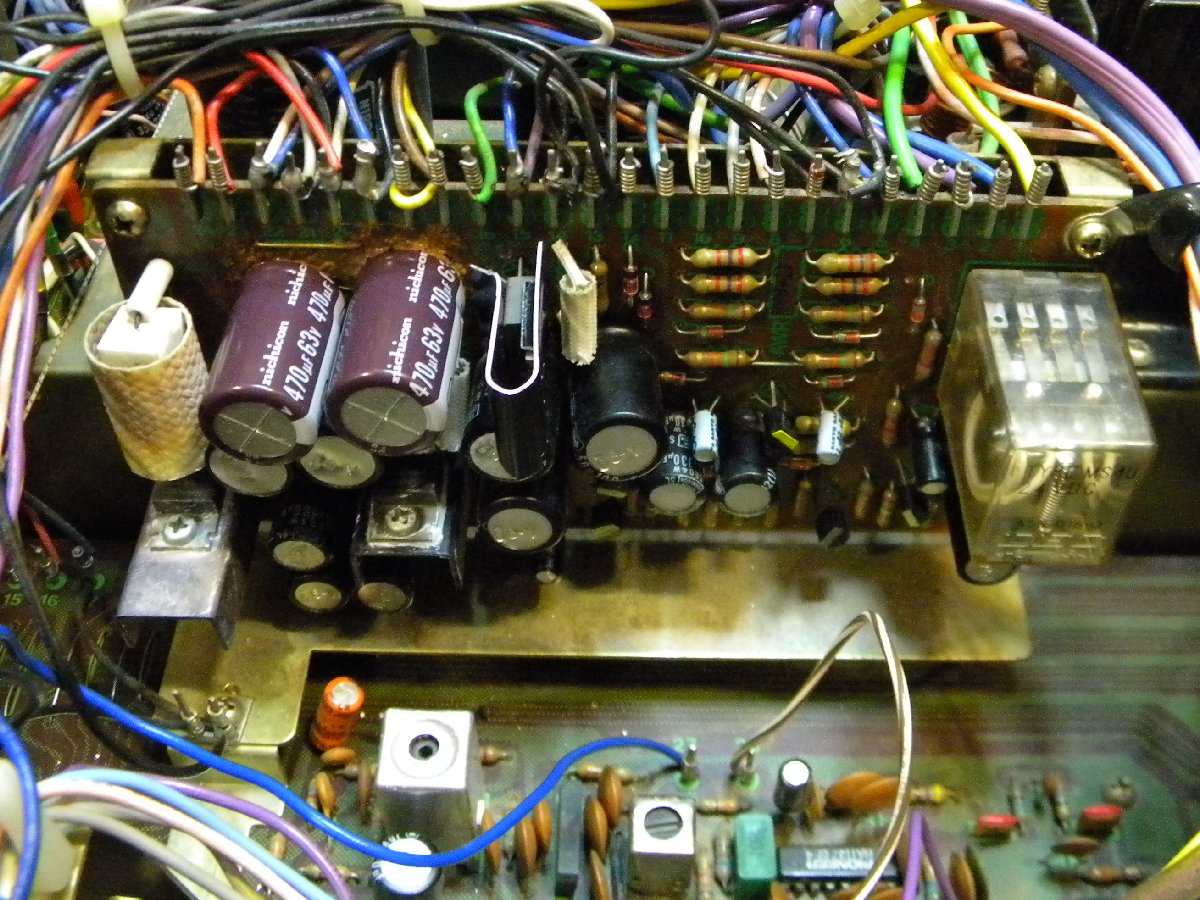Hello, i'm new here, first post: i'm from italy and i apologize for my bad english: i hope someone will help me in fixing this amazing receiver. I refer to the post of BFried member ( http://www.audiokarma.org/forums/showthread.php?t=572125 ) that reports a similar issue. But i have something different: the noise at both channel. After 2 minutes of good sound, no matter the input or output ( aux, phono, tuner.....headphones or speakers ), no matter volume, tone or any controls, cracking and popping appears for 5, 10 seconds and finally the relays cuts off signal. If i power off and on the unit the problem repeats. So, i have deoxided EVERYTHING, but no results. Following the the speculation of BFried old post i thnink the problem is in the power supply and protection assembly. I test voltages with both digital and analogue instruments. This is what i found: on power supply AWR-100 nothing strange, all voltages are between 1% tolerance with schematics, fuses ok. So i went up on AWR-099 power supply and protection assembly and i found this:
Q8: SCHEM. 30V, READ 30V TO 26V VARIABLE ON FM INPUT, 40V STABLE ALL OTHER INPUT, ON LANE 22, READ 12,4 V ALL INPUT
Q3: SCHEM. 13,5V, READ 13 V STABLE ALL INPUT
Q10: SCHEM. 46V, READ 43,5V TO 47,5V VARIABLE ON FM INPUT, 46V STABLE ALL OTHER INPUT, ON LANE 23, READ 32,2V STABLE ALL INPUT
Q11: SCHEM. 34,4V, READ 32V STABLE ALL INPUT,
SCHEM. 14V, READ 14V ALL INPUT
Q12: SCHEM. -35V, READ -38V STABLE ALL INPUT
- SCHEM. -48V, READ -48V STABLE ALL INPUT
Q7: SCHEM. 12V, READ, ON POWER ON, 30V PEAK WITH ANALOGUE MULTIMETER, SLOWLY FALLING DOWN TO 8,3V, ON POWER OFF PEAK UP TO 18V, THEN GO TO ZERO, WITH ALL INPUT
- SCHEM. 12,5V, READ 8,3V STABLE ALL INPUT, NO PEAK
Q6: SCHEM. 13V, READ 8,9V, STABLE ALL INPUT, NO PEAK
-SCHEM. -1,5V, READ -1,5V, STABLE ALL INPUT, NO PEAK
ALL OTHER Q'S VOLTAGES ON BOARD ARE STABLE BETWEEN +/- 5%
NOTE: Q8 and partially Q10 runs VERY hot rising up from power on until i power off.
All voltages are read with 235v ac.
The unit is all original, no service jobs inside, everything in power amp runs cold, the caps are externally all good, fm, am and all other input sounds very good until cracks appears
Someone will help me ? I have no ideas for such a lot of strange voltages... i suspect q8, q10, q6, q7 or some bad cap or diode around these... but before working with solder on components i prefer to ask you for any help. Note: i work usually with tubes circuits, i have little experience with transistors.
Thanks for your patience.
Q8: SCHEM. 30V, READ 30V TO 26V VARIABLE ON FM INPUT, 40V STABLE ALL OTHER INPUT, ON LANE 22, READ 12,4 V ALL INPUT
Q3: SCHEM. 13,5V, READ 13 V STABLE ALL INPUT
Q10: SCHEM. 46V, READ 43,5V TO 47,5V VARIABLE ON FM INPUT, 46V STABLE ALL OTHER INPUT, ON LANE 23, READ 32,2V STABLE ALL INPUT
Q11: SCHEM. 34,4V, READ 32V STABLE ALL INPUT,
SCHEM. 14V, READ 14V ALL INPUT
Q12: SCHEM. -35V, READ -38V STABLE ALL INPUT
- SCHEM. -48V, READ -48V STABLE ALL INPUT
Q7: SCHEM. 12V, READ, ON POWER ON, 30V PEAK WITH ANALOGUE MULTIMETER, SLOWLY FALLING DOWN TO 8,3V, ON POWER OFF PEAK UP TO 18V, THEN GO TO ZERO, WITH ALL INPUT
- SCHEM. 12,5V, READ 8,3V STABLE ALL INPUT, NO PEAK
Q6: SCHEM. 13V, READ 8,9V, STABLE ALL INPUT, NO PEAK
-SCHEM. -1,5V, READ -1,5V, STABLE ALL INPUT, NO PEAK
ALL OTHER Q'S VOLTAGES ON BOARD ARE STABLE BETWEEN +/- 5%
NOTE: Q8 and partially Q10 runs VERY hot rising up from power on until i power off.
All voltages are read with 235v ac.
The unit is all original, no service jobs inside, everything in power amp runs cold, the caps are externally all good, fm, am and all other input sounds very good until cracks appears
Someone will help me ? I have no ideas for such a lot of strange voltages... i suspect q8, q10, q6, q7 or some bad cap or diode around these... but before working with solder on components i prefer to ask you for any help. Note: i work usually with tubes circuits, i have little experience with transistors.
Thanks for your patience.


![20150117_143749[1].jpg](/forums/data/attachments/449/449824-c3ec457208ff5d294c57f8004276d19c.jpg)


